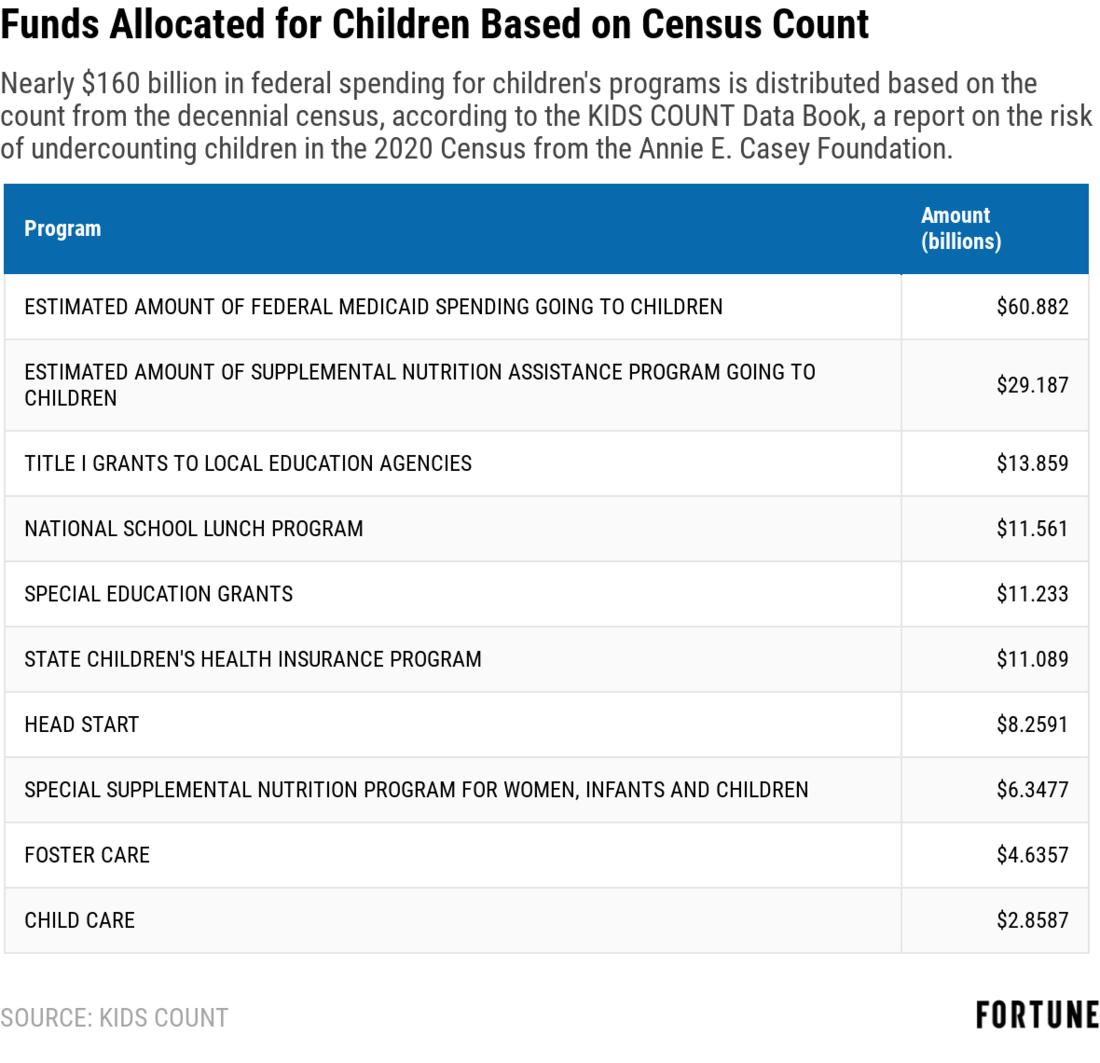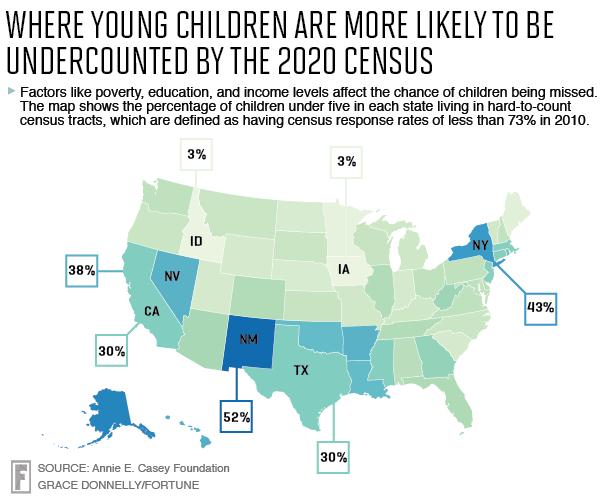美国2020年人口普查:你知道孩子们都在哪儿吗?

|
近几周,特朗普政府备受争议的“骨肉分离”政策一直是美国的焦点。现在这项政策已经终止。然而一份新的报告从另外一个角度证明了:美国政府忽略了包括一些非法入境儿童在内的孩子们的需求。 上周三,安妮·E·凯西基金会(The Annie E. Casey Foundation)发布了年度《儿童普查数据手册》,这份报告评估了最有可能无法充分统计儿童人口的地区,其结果表明,5岁以下的美国儿童有近四分之一居住在这些难以开展人口普查的地区。 5岁以下儿童在人口普查中遭遗漏的比例最高,那些最弱势的孩子更是如此。这很重要,乔治华盛顿公共政策学院(George Washington’s Institute of Public Policy)研究了10年一次的人口普查对联邦政府资金分配的影响,结果显示人口普查决定了选票和国会议员的分布情况,也左右着8000多亿美元联邦政府资金的分配。 凯西基金会的报告指出:“如果不把面临最大障碍的那些孩子计算在内,就等于无视他们以及他们的需求,这会令其前途变得不明朗。” 因此可以说,美国政府最不可能充分体现的就是小孩子的需要。他们在教育和医疗等资源上获得充足资金的可能性较小。美国各地的弱势社区中的孩子获得足够资源的可能性也最低。 其他年龄段群体被遗漏的比例要低得多。在5岁以下儿童中,人口普查的遗漏比率为二十分之一,排名第二的5-9岁年龄段的遗漏率则为五十分之一。《儿童普查数据手册》指出,在5岁以下人群中,政府遗漏黑人和拉丁裔儿童的情况是白人儿童的两倍以上。 2015年,针对幼儿的10大措施一共使用了1600亿美元政府拨款。但这些资金不足以覆盖人口普查遗漏的那些儿童。实际上,乔治华盛顿公共政策学院的研究表明,2015年为五个健康和居民服务项目拨款时,有37个州出现了前一次人口普查每遗漏一人就损失逾1000美元的情况。这五个项目包括医疗补助、儿童医保、Title IV-E抚养金、Title IV-E领养协助以及儿童照料和发展基金。 |
In recent weeks, America has been focused on the Trump administration’s controversial—and now ended—policy of separating parents and children at the border. Now, a new report reveals another way in which the needs of children, including some undocumented children, are being ignored by the U.S. government. The Annie E. Casey Foundation (AECF) published its an annual KIDS COUNT Data Book, which assesses the regions at the highest risk for undercounting children on last Wednesday. The 2018 report shows that nearly one in four children under the age of five lives in one of these hard-to-count census tracts. Children younger than five years old—particularly those in the most vulnerable situations—face the highest rates of undercount by the census. That matters because the census determines distribution of electoral votes and representation in Congress and dictates the allocation of more than $800 billion in federal spending, according to a study by George Washington’s Institute of Public Policy on the role of the decennial census is distributing federal funds. “If we don’t count the kids facing the greatest obstacles, we essentially make them and their needs invisible — and their future uncertain,” the AECF report says. As a result, the needs of young children are the least likely to be represented fairly in the U.S. government. They are less likely to receive adequate funding for resources like their education and healthcare. And kids in vulnerable communities across the country are the least likely to be given enough resources. Other age groups are overlooked at much lower rates. The census misses one in 20 children under the age of five, but the second-highest rate is for children five to nine years and the census fails to count one in 50 kids in this group. Within the youngest age group, the government misses Black and Latino children more than twice as often often as their white peers, according to the KIDS COUNT report. In 2015, ten of the largest programs that provide for young children accounted for a total of $160 billion in government allotments. But these funds are not sufficient to cover the population missed by the Census. In fact, the George Washington study found 37 states lost more than $1,000 per person missed by the last census when funding five Health and Human Services programs in 2015: Medicaid, the Children’s Health Insurance Program, Title IV-E Foster Care, Title IV-E Adoption Assistance, and the Child Care and Development Fund. |

|
基于人口普查结果分配的联邦儿童项目资金近1600亿美元。 这并非新问题:2010年美国人口普查漏掉了近100万5岁以下的儿童。 但近两年一直在研究这个问题的人口统计学家比尔·奥黑尔博士在美国人口学会(Population Association of America)作的报告中称,1980年以来,美国的最低年龄段人口普查工作每况愈下,而在此期间其他年龄段的人口普查准确率却持续上升。对于最低年龄段的遗漏比例为何远高于其他年龄段,专家们尚无明确答案,但他们找到了一些引发这个问题的因素。 评估人口普查遗漏儿童的风险时,凯西基金会的报告采用的依据是一些人口指标,比如平均受教育水平、贫困率、住房成本、非英语家庭占比等等,从而使收集幼儿及其家庭的数据变的更加困难。 该基金会负责政策改革和宣传的副主任劳拉·斯佩尔告诉《财富》杂志,“最需要[资金和资源]的孩子们往往被漏掉了”,原因是有些因素造成弱势社区的人口统计做的不够充分。同时,在最有可能被遗漏的家庭中,幼儿的比例都偏高。 |
Nearly $160 billion in federal spending for children's programs is distributed based on census counts. This is not a new problem: In 2010, the U.S. Census failed to count nearly one million children younger than five. But Dr. Bill O’Hare, a demographer who has been studying the topic for the last two years, said in a presentation by the Population Association of America that the problem of counting the youngest Americans has gotten worse with each census since 1980 — during the same period that the accurate enumeration of other age groups has improved. Experts don’t know exactly why the rates of undercounting this age group are so much higher than any other, but they have identified factors that lead to less accurate counts. The foundation’s report assesses risk of children being missed based on population traits like average education levels, poverty rates, housing costs, share of non-English speaking households, and a variety of other factors that make it more difficult to collect data on small children and their families. “It’s often the children who need [funding and resources] most that don’t get counted,” Laura Speer, associate director for policy reform and advocacy at AECF, told Fortune, due to the factors that contribute to the undercount of vulnerable communities. And the households most likely to be missed have a disproportionate share of young children. |

|
美国人口调查局已连续六年资金不足,而且从2017年6月起就一直没有常驻负责人。除此之外,该局人员在开展人口普查并准确记录美国幼儿数量时还遇到了其他一些障碍,而人口普查结果将左右联邦、州以及地方层面今后10年的决策。 复杂的家庭结构 由于10年一次的人口普查是按家庭进行,非双亲结构的家庭会让确保所有儿童得到准确统计变得更加困难。据斯佩尔介绍,“复杂的家庭结构”包括多个家庭共同拥有监护权、在多代同堂环境中长大的儿童以及住房保障情况差或者住房没有保障的家庭。 儿童贫困率 在凯西基金会的美国各州儿童幸福水平排名中,新墨西哥州位列末席,其儿童贫困率和就业不安全感却高居榜首,四年级学生的阅读能力落后,还有读了四年却不能毕业的高中生。该州在2020年人口普查中可能遗漏的儿童数量也超过其他地区。在2010年的普查中,反馈率不足75%的普查区占新墨西哥州所有普查区的52%。新墨西哥州属丹佛人口调查分局管辖。人口调查局网站显示,这个分局负责的地区包括亚利桑那州、科罗拉多州、堪萨斯州、蒙大拿州、内布拉斯加州、北达科他州、俄克拉荷马州、南达科他州、得克萨斯州、犹他州以及怀俄明州,目前有11名员工。 丹佛分局拒绝证实这些数字,但建议《财富》杂志询问人口调查局公共信息办公室。该办公室则未对确认相关数字的要求做出回应,也没有更改网上披露的员工人数。 移民社区和不会说英语的居民 纽约市人口中的移民比例居美国所有城市之首,它所在的纽约州同样存在挑战。在这个州,可能得不到完全统计的儿童超过50万人,占该州儿童总数的43%。2016年,五分之一的纽约州儿童处于贫困状态。纽约地区人口调查分局的网站显示,目前该局有7名员工,而他们还管辖着康涅狄格州、缅因州、马萨诸塞州、新罕布什尔州、新泽西州、波多黎各、罗德岛以及佛蒙特州。 然而,就算在统计最准确的地方,比如仅有3%的5岁以下儿童住在困难普查区的爱荷华州,按2010年的反馈率计算,2020年的人口普查仍有可能漏掉7000名幼儿。 斯佩尔指出,政府无法拿出美国弱势人群的准确数据,这对所有家庭以及美国儿童的幸福来说就是失败,对美国下一代人未来的健康而言也是失败。 2020年之前能做些什么? 斯佩尔认为,对于关心此事的居民来说,他们能做的最重要的事就是去找当地政府和州政府,问问他们在向选民宣传下次人口普查方面做了哪些工作。现在采取措施来提高2020年的幼儿统计准确率还不算晚。 她还说,州和地方政府可以划拨资金来支持本次人口普查。加州就在这样做——专家则预计加州的2020年人口普查将遗漏75万名儿童。这次普查将询问受访者的公民身份,而加州政府已就此起诉联邦政府;同时,加州政府官员正联手社区负责人为本次人口普查做宣传,以解决统计不完善问题。 同时,鉴于人口调查局已经就2020年人口普查进行了一些实地测试,再加上本次普查将首次以数字问卷为主要调查方式,上述措施就更为重要。目前还没有用含有公民身份问题的问卷进行过测试,但专家认为这将使非美国公民群体的反馈率下降。凯文基金会的报告指出,在美国,有600万拥有美国公民身份的儿童生活在至少有一名非法入境者的家庭里,因此询问公民身份不利于准确统计幼儿的数量。 斯佩尔强调,要提高弱势地区的反馈率并给予家庭支持以便他们过上好日子,关键就在于和受信任的地方官员以及教师、医疗工作者、工会领导人和牧师等社区成员建立联系。 她说:“现在,很多社区都对政府的作用感到更害怕。我们担心这会影响人们填写人口普查问卷的意愿。所以说这一点非常重要。” 肯尼斯·普鲁伊特曾在1998-2001年担任人口调查局负责人,他认为应在隐私和准确性之间求得平衡。普鲁伊特告诉网络媒体FiveThirtyEight,人们认为涉及隐私的信息越多,普查结果就越不准确。 安娜·玛利亚·巴里-杰斯特在FiveThirtyEight网站上写道:“普鲁伊特说这和2020年人口普查紧密相关,威胁到这次普查的不光是那个公民身份问题。一场关于移民的全国性政治辩论以及为了去掉这个问题的多场官司把这次普查困在中间,由此产生的分化可能会对反馈率产生不利影响。” 斯佩尔指出:“归根到底,问题就在于所有人都有权被纳入人口普查范围内。”她说美国一直在进步,但也承认仍有很大的改善空间。 “这次人口普查可能威胁到我们已经取得的一些进展。”(财富中文网) 译者:Charlie 审校:夏林
|
Beyond the fact that the Census Bureau’s budget has been underfunded for the last six years and that it has operated without a permanent director since June 2017, here are a few of the obstacles facing the employees that administer the survey—the results of which will determine decisions from federal to state to local levels for the next ten years—as they attempt to accurately count the young child population in the country: Complex family living arrangements Since the 10-year Census is designed to be administered by household, living arrangements outside of a two-parent home make it more challenging to ensure all children have been counted accurately. “Complex living arrangements” can include families who share custody, children being raised by extended family, and households with low or no housing security, according to Speer. Child poverty rates New Mexico came last in the AECF’s state ranking of children’s wellbeing, with the highest levels of child poverty, job insecurity, fourth graders behind in reading skills, and high school students failing to graduate in four years. New Mexico also has the the highest population of children at risk to be missed in 2020, with 52% of census tracts returning less than three-quarters of the surveys sent out in 2010, falls into jurisdiction of the Denver regional census branch. This office is responsible for Arizona, Colorado, Kansas, Montana, Nebraska, North Dakota, Oklahoma, South Dakota, Texas, Utah, and Wyoming and currently has 11 employees, according to the region’s website. The Denver Office refused to verify those figures, instead referring Fortune to Public Information Office at the Census Bureau. The PIO did not respond to requests to confirm or correct the staff numbers listed online. Immigrant communities and non-english speakers In New York, home to the U.S. city with the highest percentage of immigrant residents, faces challenges as well. More than half a million kids in the state—or 43%—live in census blocks at risk of being undercounted and one in five kids lived in poverty in 2016. The New York regional census office currently employs seven people, according to their website. This staff is also responsible for Connecticut, Maine, Massachusetts, New Hampshire, New Jersey, Puerto Rico, Rhode Island, and Vermont. But even in the best case scenarios for accurate counts, like in Iowa where only 3% of children under age five live in hard-to-count zones, the Census still risks missing 7,000 young children in 2020, based on the response rates in 2010. The government’s failure to accurately represent and provide for the very most vulnerable populations in this country is a failure for all families, for the wellbeing of American children and subsequently for the future health of the nation’s next generation, explains Speer. What can be done before 2020? Speer notes that the most important thing concerned citizens can do is reach out to their local and state governments to ask what they are doing to inform their constituents about the upcoming census. It’s not too late to take steps toward improving the accuracy of counting young children in 2020. State and local governments can allocate funds to support the census, Speer says. She points to the efforts in California, where experts predict 750,000 children will be missed by the census in 2020. State officials are suing the federal government over the inclusion of the citizenship question and are working with community leaders to share information about the upcoming census in efforts to combat the undercount. And it’s especially important now, since the census bureau has already conducted some field tests of the 2020 survey, which will be the first Census distributed mainly digitally. No test run of the questionnaire including the citizenship question has been deployed so far, but experts believe it will cause noncitizen response rates to drop. The KIDS COUNT report points out that this is detrimental to accurately capturing the populations of young children when 6 million citizen children in the U.S. live in households where at least one person is undocumented. Speer emphasized that connecting with trusted local officials and community members like teachers, healthcare providers, union leaders, and clergy, is key to improving response rates in vulnerable areas and giving families the support they need to excel. “In this moment there’s an increased sense of fear across the communities around the role of government,” she said, “and we’re afraid that’s going to impact the likelihood of people wanting to fill out the census form. So it’s very important.” There’s a tradeoff between privacy and accuracy, said former census director Kenneth Prewitt, who led the bureau from 1998 to 2001. The more infringement there is on information that people view as private, the less accurate the results will be, he told FiveThirtyEight. “And this close to the 2020 survey, it’s likely not only the citizenship question that puts the census at risk, Prewitt said. That the census is now mired in a national political conversation about immigration, as well as various court cases pushing to keep the question off the survey polarizes it in a way that could hurt response rates,” Anna Maria Barry-Jester writes for the website. “In the end it’s about all people having the right to be counted and represented,” Speer said. She says there’s been progress in the country but acknowledges that there is still a lot of room for improvement. “And this census could jeopardize some of the progress that we’ve made.” |













